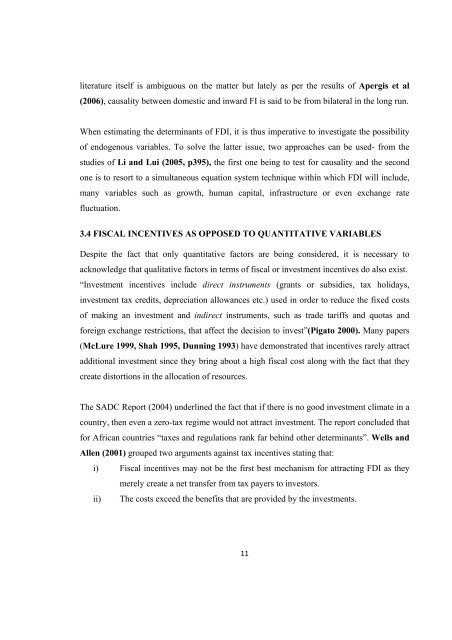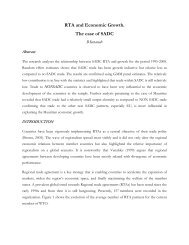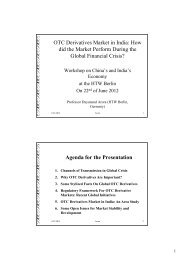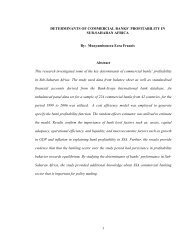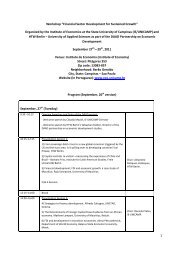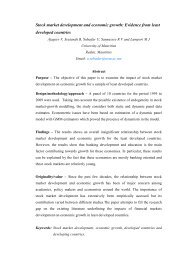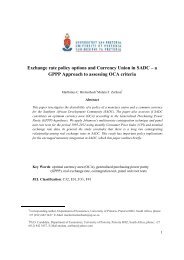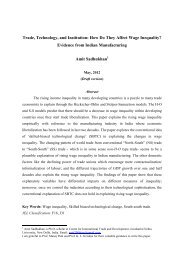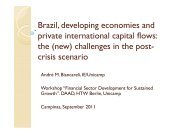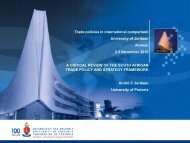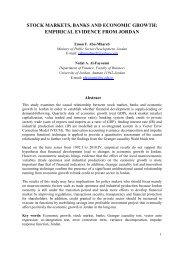On the Determinants of Foreign Capital Flows - DAAD partnership ...
On the Determinants of Foreign Capital Flows - DAAD partnership ...
On the Determinants of Foreign Capital Flows - DAAD partnership ...
You also want an ePaper? Increase the reach of your titles
YUMPU automatically turns print PDFs into web optimized ePapers that Google loves.
literature itself is ambiguous on <strong>the</strong> matter but lately as per <strong>the</strong> results <strong>of</strong> Apergis et al<br />
(2006), causality between domestic and inward FI is said to be from bilateral in <strong>the</strong> long run.<br />
When estimating <strong>the</strong> determinants <strong>of</strong> FDI, it is thus imperative to investigate <strong>the</strong> possibility<br />
<strong>of</strong> endogenous variables. To solve <strong>the</strong> latter issue, two approaches can be used- from <strong>the</strong><br />
studies <strong>of</strong> Li and Lui (2005, p395), <strong>the</strong> first one being to test for causality and <strong>the</strong> second<br />
one is to resort to a simultaneous equation system technique within which FDI will include,<br />
many variables such as growth, human capital, infrastructure or even exchange rate<br />
fluctuation.<br />
3.4 FISCAL INCENTIVES AS OPPOSED TO QUANTITATIVE VARIABLES<br />
Despite <strong>the</strong> fact that only quantitative factors are being considered, it is necessary to<br />
acknowledge that qualitative factors in terms <strong>of</strong> fiscal or investment incentives do also exist.<br />
“Investment incentives include direct instruments (grants or subsidies, tax holidays,<br />
investment tax credits, depreciation allowances etc.) used in order to reduce <strong>the</strong> fixed costs<br />
<strong>of</strong> making an investment and indirect instruments, such as trade tariffs and quotas and<br />
foreign exchange restrictions, that affect <strong>the</strong> decision to invest”(Pigato 2000). Many papers<br />
(McLure 1999, Shah 1995, Dunning 1993) have demonstrated that incentives rarely attract<br />
additional investment since <strong>the</strong>y bring about a high fiscal cost along with <strong>the</strong> fact that <strong>the</strong>y<br />
create distortions in <strong>the</strong> allocation <strong>of</strong> resources.<br />
The SADC Report (2004) underlined <strong>the</strong> fact that if <strong>the</strong>re is no good investment climate in a<br />
country, <strong>the</strong>n even a zero-tax regime would not attract investment. The report concluded that<br />
for African countries “taxes and regulations rank far behind o<strong>the</strong>r determinants”. Wells and<br />
Allen (2001) grouped two arguments against tax incentives stating that:<br />
i) Fiscal incentives may not be <strong>the</strong> first best mechanism for attracting FDI as <strong>the</strong>y<br />
merely create a net transfer from tax payers to investors.<br />
ii) The costs exceed <strong>the</strong> benefits that are provided by <strong>the</strong> investments.<br />
11


